
ENGLISH
Introduction
Congratulations on your purchase and welcome to
Philips! To fully benet from the support that Philips offers,
register your product at www.philips.com/welcome.
General description (Fig. 1)
A Spray nozzle
B Cap of lling opening
C Steam control
O = no steam
l = minimum steam
; = maximum steam
1 = Calc-Clean function
D Shot-of-steam button 9 (all types except GC2510)
E Spray button T
F Automatic shut-off light (GC2560 only)
G Mains cord
H Anti-Calc tablet (all types except GC2522/GC2510)
I Temperature light
J Type plate
K Water tank
L Temperature dial
Important
Read this user manual carefully before you use the
appliance and save it for future reference.
Danger
Never immerse the iron in water.
Warning
Check if the voltage indicated on the appliance
corresponds to the local mains voltage before you
connect the appliance.
Do not use the appliance if the plug, the mains cord
or the appliance itself shows visible damage, or if the
appliance has been dropped or leaks.
If the mains cord is damaged, you must have it
replaced by Philips, a service centre authorised by
Philips or similarly qualied persons in order to avoid
a hazard.
Never leave the appliance unattended when it is
connected to the mains.
This appliance is not intended for use by persons
(including children) with reduced physical, sensory
or mental capabilities, or lack of experience and
knowledge, unless they have been given supervision
or instruction concerning use of the appliance by a
person responsible for their safety.
Children should be supervised to ensure that they
do not play with the appliance.
Do not let the mains cord come into contact with
the hot soleplate of the iron.
Caution
Only connect the appliance to an earthed wall
socket.
Check the mains cord regularly for possible damage.
The soleplate of the iron can become extremely hot
and may cause burns if touched.
When you have nished ironing, when you clean the
appliance, when you ll or empty the water tank and
also when you leave the iron even for a short while:
set the steam control to position O, put the iron on
its heel and remove the mains plug from the wall
socket.
Always place and use the iron on a stable, level and
horizontal surface.
Do not put perfume, vinegar, starch, descaling agents,
ironing aids or other chemicals in the water tank.
This appliance is intended for household use only.
Electromagnetic elds (EMF)
This Philips appliance complies with all standards
regarding electromagnetic elds (EMF). If handled
properly and according to the instructions in this user
manual, the appliance is safe to use based on scientic
evidence available today.
Before first use
1 Remove any sticker or protective foil from the
soleplate.
2 Let the iron heat up to maximum temperature and
pass the iron over a piece of damp cloth for several
minutes to remove any residues from the soleplate.
-
-
-
-
-
-
-
-
-
-
-
-
-
-
-
-
-
-
-
Preparing for use
Filling the water tank
Do not put perfume, vinegar, starch, descaling agents,
ironing aids, chemically descaled water or other
chemicals in the water tank.
1 Switch off the appliance and unplug it.
2 Set the steam control to position O (= no
steam) (Fig. 2).
3 Openthecapofthellingopening.
4 Tilttheironandllthewatertankuptomaximum
level under the tap (Fig. 3).
Note: Do not ll the water tank beyond the MAX indication.
Note: If the tap water in your area is very hard, we advise
you to use distilled water. Do not use chemically descaled
water.
5 Closethecapofthellingopening(‘click’).
Setting the temperature
1 Put the iron on its heel (Fig. 4).
2 To set the required ironing temperature, turn the
temperature dial to the appropriate position.
Check the laundry care label for the required ironing
temperature.
1 Synthetic fabrics (e.g. acrylic, viscose, polyamide,
polyester)
1 Silk
2 Wool
3 Cotton, linen
If you do not know what kind or kinds of fabric an article
is made of, determine the right ironing temperature by
ironing a part that is not visible when you wear or use
the article.
Silk, woollen and synthetic materials: iron the reverse side
of the fabric to prevent shiny patches. Avoid using the
spray function to prevent stains. Start ironing the articles
that require the lowest ironing temperature, such as those
made of synthetic bres.
3 Put the mains plug in an earthed wall socket.
The temperature light goes on.
4 When the temperature light goes out, wait a while
before you start ironing.
During ironing, the temperature light goes on from
time to time. This indicates that the iron is heating
up to the set temperature.
Using the appliance
Note: The iron may give off some smoke when you use it for
the rst time. This stops after a short while.
Steam ironing
1 Make sure that there is enough water in the water
tank.
2 Set the recommended ironing temperature (see
chapter‘Preparingforuse’,section‘Settingthe
temperature’).
3 Set the appropriate steam setting. Make sure
that the steam setting is suitable for the ironing
temperature selected: (Fig. 2)
ç for minimum steam (temperature settings 2 and
3).
é for maximum steam (temperature settings 3
to MAX).
Note: The iron starts to produce steam as soon as it has
reached the set temperature.
GC2640/GC2620/GC2530/GC2528/
GC2520/GC2510 only:
Water may leak from the soleplate if the set temperature
is too low (MIN to 2).
Ironing without steam
1 Set the steam control to position O (= no steam).
2 Set the recommended ironing temperature (see
chapter‘Preparingforuse’,section‘Settingthe
temperature’).
-
-
-
-
,
,
-
-
Features
Spray function
You can use the spray function at any temperature
to moisten the article to be ironed. This helps
remove stubborn creases.
1 Make sure that there is enough water in the water
tank.
2 Press the spray button several times to moisten the
article to be ironed (Fig. 5).
Shot of steam (all types except GC2510)
A powerful shot of steam helps to remove very stubborn
creases.
The shot-of-steam function only works at temperature
settings between 2 and MAX.
1 Press and release the shot-of-steam button (Fig. 6).
Vertical shot of steam (all types except
GC2510)
You can also use the shot-of-steam function when
you hold the iron in vertical position. This is useful for
removing creases from hanging clothes, curtains etc.
1 Hold the iron in vertical position and press and
release the shot-of-steam button (Fig. 7).
Never direct the steam at people.
Drip stop (GC2652/GC2650/GC2560/
GC2522 only)
This iron is equipped with a drip-stop function: the
iron automatically stops producing steam when the
temperature is too low to prevent water from dripping
out of the soleplate. When this happens you hear a click.
Automatic shut-off function (GC2560 only)
The automatic shut-off function automatically switches off
the iron if it has not been moved for a while.
Theautomaticshut-offlightashestoindicatethat
the iron has been switched off by the automatic
shut-off function. (Fig. 8)
To let the iron heat up again:
1 Pick up the iron or move it slightly.
The automatic shut-off light goes out.
If the temperature of the soleplate has dropped
below the set ironing temperature, the temperature
light goes on.
2 If the temperature light goes on after you have
moved the iron, wait for it to go out before you
start ironing.
Note: If the temperature light does not go on after you move
the iron, the soleplate still has the right temperature and the
iron is ready for use.
Cleaning and maintenance
Cleaning
1 Set the steam control to position O, remove the
plug from the wall socket and let the iron cool
down.
2 Wipeakesandanyotherdepositsoffthe
soleplate with a damp cloth and a non-abrasive
(liquid) cleaning agent.
To keep the soleplate smooth, avoid hard contact with
metal objects. Never use a scouring pad, vinegar or
other chemicals to clean the soleplate.
3 Clean the upper part of the iron with a damp cloth.
4 Regularly rinse the water tank with water. Empty
the water tank after you have rinsed it (Fig. 9).
Double-Active Calc System (all types except
GC2522/GC2510)
The Double-Active Calc System consists of an Anti-Calc
tablet inside the water tank combined with the Calc-
Clean function.
The Anti-Calc tablet prevents scale from clogging the
steam vents. The tablet is constantly active and does
not need to be replaced (Fig. 10).
The Calc-Clean function removes scale particles
from the iron.
,
,
,
-
-

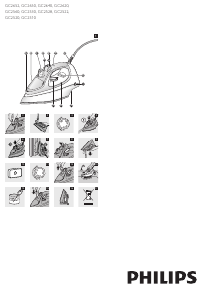


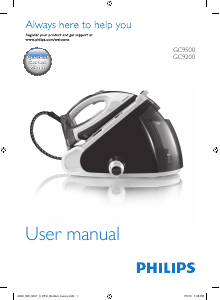
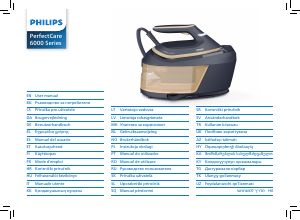
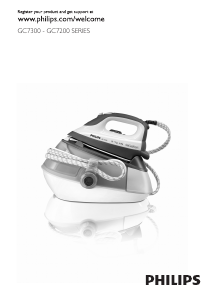
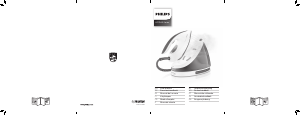

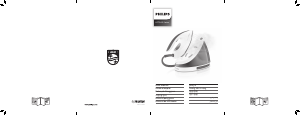
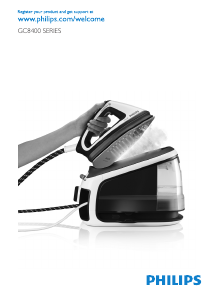
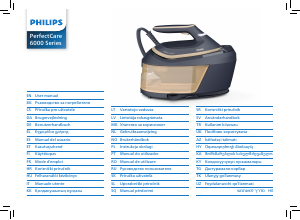
Joignez-vous à la conversation sur ce produit
Ici, vous pouvez partager ce que vous pensez du Philips GC2510 Fer à repasser. Si vous avez une question, lisez d’abord attentivement le mode d’emploi. La demande d’un mode d’emploi peut être effectuée en utilisant notre formulaire de contact.
répondre | Cela a été utile (0)